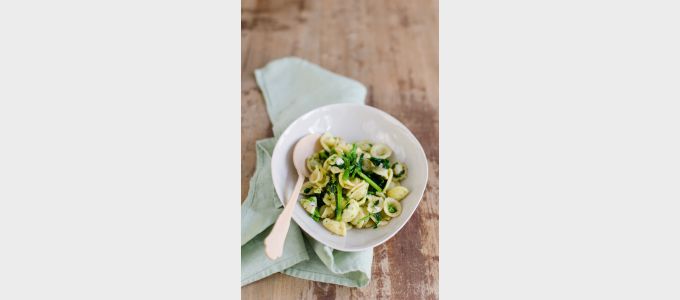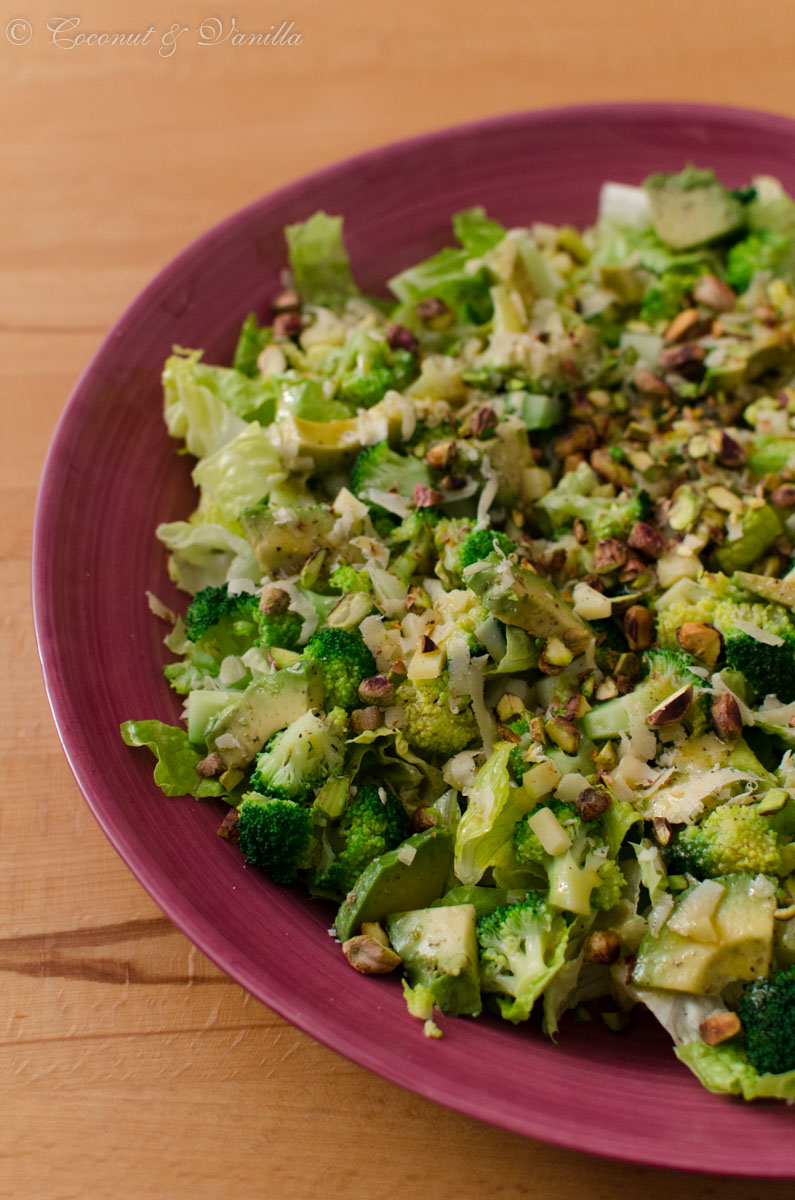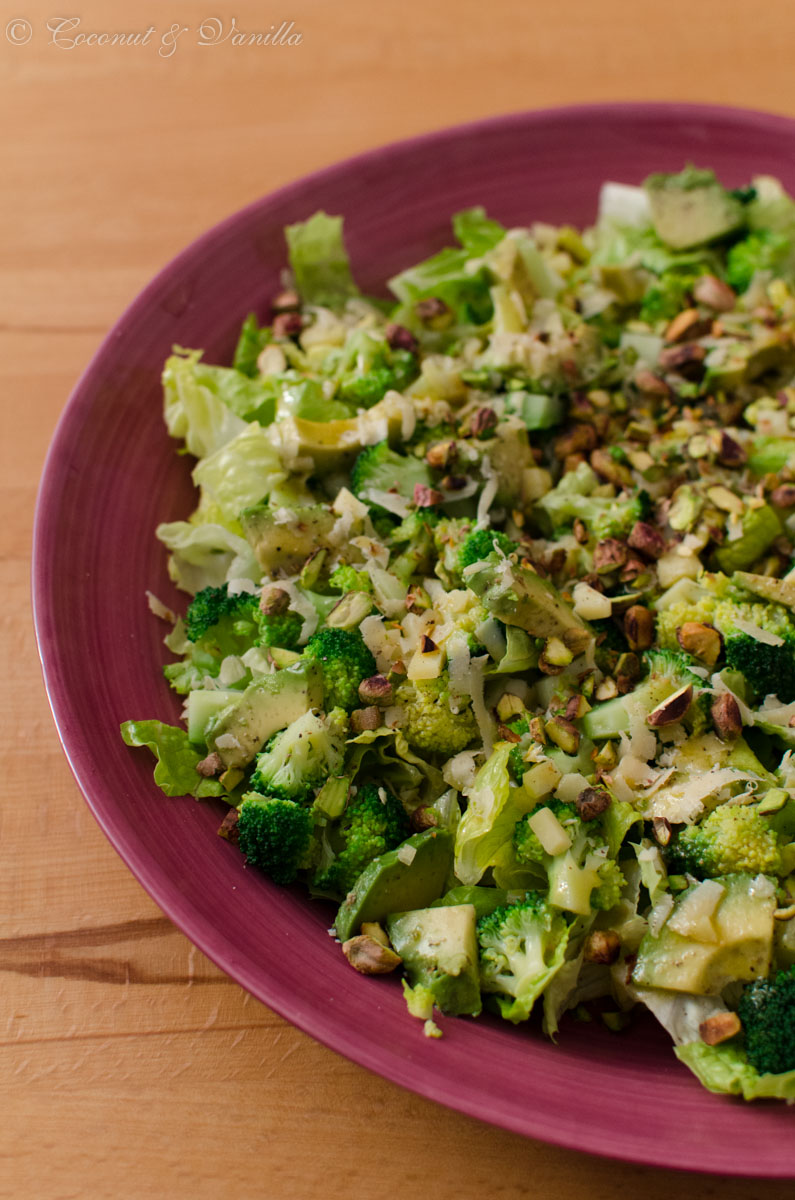Als ich kürzlich in Italien war musste ich natürlich halb Italien leer kaufen ;). In der Gemüseabteilung ist mir dann auch die ein oder andere italienische Spezialität unter die Finger gekommen, wie Cima di Rapa. Wenn ich so etwas sehe muss ich es auf jeden Fall mitnehmen, da führt kein Weg daran vorbei! Eine Zubereitungsweise wird sich zu Hause dann schon finden. In diesem Fall wurde es ein einfaches aber wohlschmeckendes Pastagericht, in dem der Cima di Rapa wundervoll zur Geltung kommt!
Cima di Rapa ist übrigens ein Stängelkohl und ein ähnliches früher in Deutschland bekanntes Gemüse heißt Rübstiel. Cima di Rapa besteht aus langen Stielen, vielen Blättern und ein paar kleinen Röschen die aussehen wie Brokkoliröschen. Er schmeckt ähnlich wie Brokkoli, manchmal etwas bitter, aber das hielt sich bei meinem echt sehr in Grenzen (wahrscheinlich war er auch noch sehr jung). Sehr große Blätter und dicke Stängel sollte man entfernen, da diese besonders bitter sind. Die dickeren Stängel sind auch nicht mehr zart.
Ein interessantes Gemüse, gerade weil es aus einer ausgewogenen Mischung von Blättern und Stängeln besteht. Die Stängel sind zart und knackig und wie beim Brokkoli besonders lecker!

Vor einem Jahr: Kartoffelquiche mit Bärlauchguss
Vor zwei Jahren: Linguine mit Blumenkohlpesto
Vor drei Jahren: Orangen-Pasta mit Serranoschinken
Vor vier Jahren: Rhabarbermuffins
Orecchiette mit Cima di Rapa
ergibt: 4 Portionen
Zutaten:
- 500 – 600 g Cima di Rapa (1 Bund)
- 500 g Orecchiette
- Meersalz
- 1 Knoblauchzehe, gehackt
- 2 Sardellenfilets
- 1 kleine Chilischote, fein gehackt
- Olivenöl
- Pfeffer, frisch gemahlen
- Parmesan oder Pecorino, frisch gerieben
Große Blätter und dicke Stängel vom Cima di Rapa abschneiden und wegwerfen. Den Rest grob schneiden.
Die Orecchiette in einem großen Topf mit Salzwasser kochen. 4 Minuten vor Ende der Garzeit den Cima di Rapa dazugeben. Wenn die Orecchiette gar sind, abgießen.
Im gleichen Topf einen großzügigen Schuss Olivenöl bei mittlerer Hitze erwärmen. Knoblauch, Sardellen und Chili darin andünsten, bis die Sardellen zerlaufen. Pasta und Cima di Rapa dazugeben, unterheben und vom Herd nehmen. Mit Pfeffer und gegebenfalls Salz würzen.
Mit frisch geriebenem Parmesan servieren.
Recently I was in Italy and of course I shopped a lot of groceries there ;). I discovered some italian specialties , like cima di rapa. When I see something special like this I have to buy it! What I will do with, I’ll figure out at home. In this case I made an easy, but very delicious pasta dish, which features the cima di rapa perfectly!
Cima di Rapa is broccoli rabe, which was also more known in Germany in older days. Cima di rapa are long stalks with a lot of leaves and some little florets, like of broccoli. It tastes also similar to broccoli, sometimes a bit bitter, but mine was mild, maybe because it was very young. Very large leaves and thick stems should be removed and discarded, because they are especially bitter. The thick stems are also not tender anymore.
A very interesting vegetable, especially because it has a good mixture of leaves and stems. The stems are tender and crunchy and as those of broccoli very scrumptious!

One year ago: potato quiche with wild garlic
Two years ago: linguine with cauliflower pesto
Three years ago: orange pasta with prosciutto
Four years ago: rhubarb muffins
Orecchiette with cima di rapa
yields: 4 portions
Ingredients:
- 500 – 600 g cima di rapa (broccoli rabe) (1 bunch)
- 500 g orecchiette
- sea salt
- 1 clove of garlic, finely chopped
- 2 anchovy fillets
- 1 small chili, finely chopped
- olive oil
- black pepper, freshly ground
- parmesan or pecorino, freshly grated
Remove and discard large leaves and thick stems of the cima di rapa. Chop coarsely.
Cook the orecchiette in a large pot with salted water. 4 minutes before the end of the cooking time of the pasta add the cima di rapa. When the orecchiette are al dente, drain all.
Heat some olive oil in the same pot on middle heat. Sauté the garlic, anchovies and chili, until the anchovies are melting. Add the pasta and cima di rapa, stir in, then remove from the heat. Season with salt and pepper.
Serve with freshly grated parmesan.



